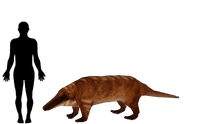| Ambulocetus | |
|---|---|

| |
| An artist's illustration of Ambulocetus natans | |
| Scientific classification | |
| Kingdom: | Animalia |
| Phylum: | Chordata |
| Class: | Mammalia |
| Order: | Artiodactyla |
| Suborder: | †Archaeoceti |
| Family: | †Ambulocetidae |
| Subfamily: | †Ambulocetinae |
| Genus: | †Ambulocetus Thewissen, Hussain, & Arif, 1994 |
| Species: | †A. natans |
| Binomial name | |
| Ambulocetus natans Thewissen, Hussain, & Arif, 1994 | |

Ambulocetus Size
Ambulocetus ("walking whale") was an early cetacean that could walk as well as swim. It lived during early Eocene some 50-49 million years ago. It is a transitional fossil that shows how whales evolved from land-living mammals. The Ambulocetus fossils were found in Pakistan by anthropologist Johannes Thewissen. When the animal was alive, Pakistan was a coastal region of India, which was then a large island in the Indian Ocean.
Although Ambulocetus looked like a furry crocodile or a giant otter, it was actually an early whale. Its back legs in particular seemed to be used for propulsion, and its feet had long, probably webbed toes (each ending in a tiny hooflet). Ambulocetus was not as agile in the water as an otter and seems to be adapted for ambushing large prey which it then drowned. Its skull shows adaptations for holding large, struggling prey underwater. Its ear bones also show that it did not have external ears but instead used the same method of hearing as modern whales - picking up vibrations through the jawbone. To detect prey on land, they may have lowered their heads to the ground and felt for vibrations. One fairly complete specimen and several partial skeletons have been found in Pakistan.
Having the appearance of a 3 meter (10-foot) long mammalian crocodile, it was clearly amphibious, as its back legs are better adapted for swimming than for walking on land, and it probably swam by undulating its back vertically, as otters and whales do. It has been speculated that Ambulocetids hunted like crocodiles, lurking in the shallows to snatch unsuspecting prey. Chemical analysis of its teeth shows that it was able to move between salt and fresh water.
Scientists consider Ambulocetus to be an early whale because it shares underwater adaptations with them: it had an adaptation in the nose that enabled it to swallow underwater, and its periotic bones had a structure like those of whales, enabling it to hear well underwater. In addition, its teeth are similar to those of early cetaceans.
Taxonomy[]
Description[]
Paleobiology[]
Paleoecology[]
In The Media[]
- It appears in the 1st episode of Walking With Prehistoric Beasts. One serves as a minor antagonist. (Anti-Villain)
- It appeared briefly as a Skeleton in the 2nd episode of the PBS Documentary Evolution “Great Transformations”.
Gallery[]
Ambulocetus/Gallery